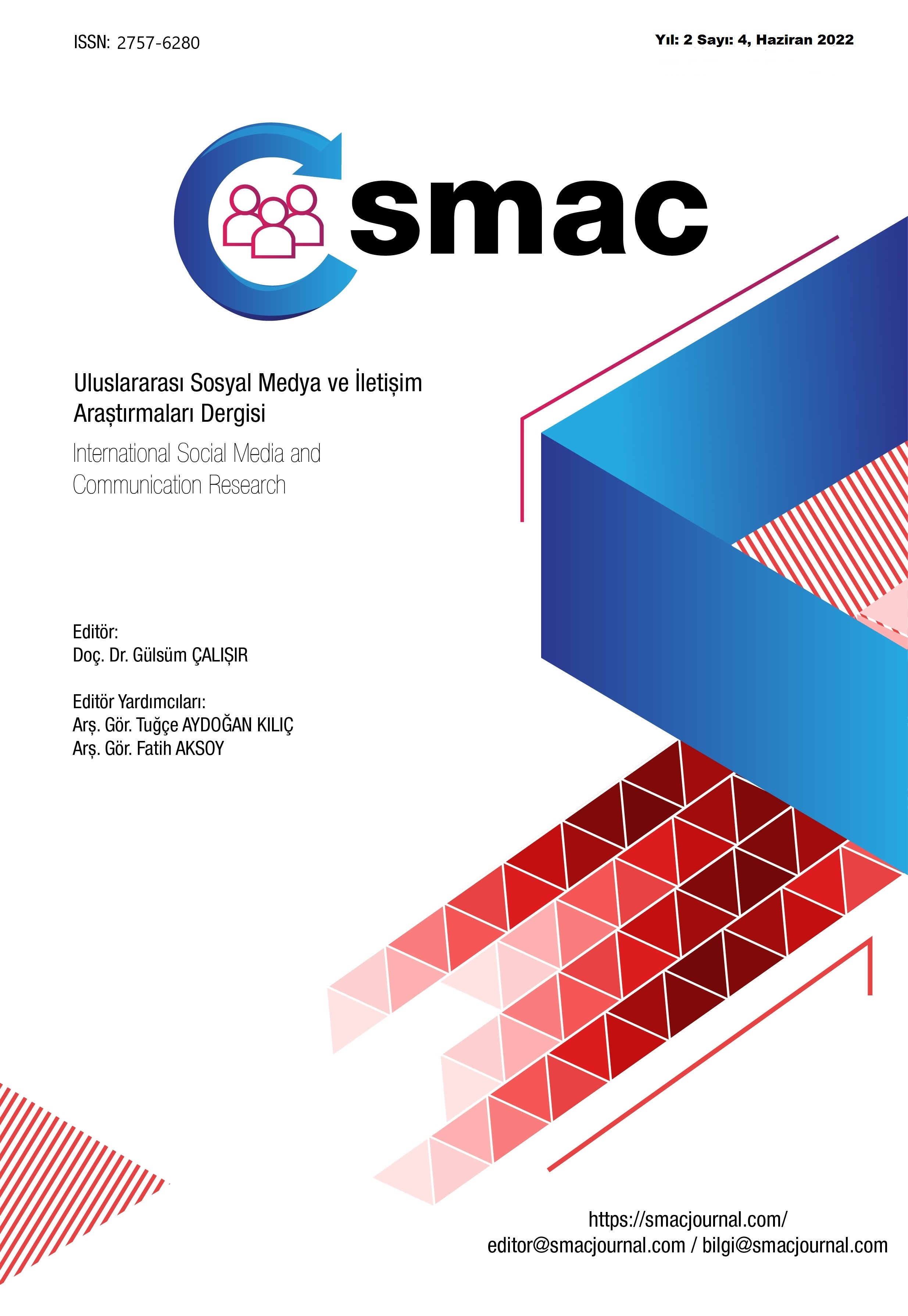Author :
Abstract
Çalışmanın amacı üniversitede öğrenim gören öğrencilerin sosyal medya pazarlama aktivitelerinin tüketici algısına etkisinin farklı değişkenlere göre belirlenmesidir. Amaç doğrultusunda çalışmanın örneklem grubunu uygun örnekleme yöntemiyle seçilen 127 Kadın 96 Erkek toplam 223 üniversite öğrencisi oluşturmaktadır. Çalışmada veri toplama aracı olarak Yadav ve Rahman (2017) tarafından geliştirilmiş, Yüksekbilgili (2018) tarafından Türkçe’ye uyarlanmış “Sosyal Medya Pazarlama Aktiviteleri Ölçeği” kullanılmıştır. Verilerin analizin katılımcıların demografik özelliklerini belirlemek için yüzde ve frekans tanımlayıcı istatistik yöntemleri kullanılmıştır. Verilerin normal dağılım gösterip göstermediğini tespit etmek için Kolmogorov Smirnov testi yapılmış ve verilerin parametrik test koşullarını sağladığı sonucuna ulaşılmıştır. Bu bağlamda Bağımsız örneklem t-tesi ile One-way Anova testleri kullanılmıştır. Sonuç olarak katılımcıların yaş, cinsiyet, sosyal medya kullanım sıklığı ve sosyal medyadan alışveriş yapma durumlarına göre sosyal medya pazarlama aktivitelerinin tüketici algısına etkileri arasında farklılık tespit edilmiştir.
Keywords
Abstract
The aim of the study is to determine the effect of social media marketing activities of university students on consumer perception according to different variables. For the purpose, the sample group of the study consists of 223 university students, 127 females and 96 males, selected by convenient sampling method. In the study, the “Social Media Marketing Activities Scale” developed by Yadav and Rahman (2017) and adapted into Turkish by Yüksekbilgili (2018) was used as a data collection tool. Percentage and frequency descriptive statistical methods were used to determine the demographic characteristics of the participants in the analysis of the data. Kolmogorov Smirnov test was performed to determine whether the data showed normal distribution and it was concluded that the data met the parametric test conditions. In this context, Independent sample t-test and One-way Anova tests were used. As a result, a difference was determined between the effects of social media marketing activities on consumer perception according to the age, gender, frequency of social media use and shopping status of the participants.
Keywords
- Atılgan, F. (2020). Sosyal Medya Pazarlaması ve Tüketici Satın Alma Değişkenleri İlişkisi. Sosyal Kimlik ve Algılanan Değerin Aracılık Rolü Üzerine Bir Araştırma [A Survey Research on the Relationship Between Social Media Marketing and Consumers’ Buying Behaviour, the Mediating Roles of Social Identity and Perceived Value], Business & Management Studies: An International Journal, 8(2), 1892-1921.
- Aytan, C., & Telci, E. E. (2014). Markaların Sosyal Medya Kullanımının Tüketici Davranışı Üzerindeki Etkileri, The Turkish Online Journal of Design, Art and Communication, 4 (4), 1-15.
- Barutçu, S., ve Tomaş, M. (2013). Sürdürülebilir sosyal medya pazarlaması ve sosyal medya pazarlaması etkinliğinin ölçümü. Journal of Internet Applications and Management, 4(1), 5-24.
- Bostancı, M. (2010). Sosyal Medyanın Gelişimi ve İletişim Fakültesi Öğrencilerinin Sosyal Medya Kullanım Alışkanlıkları, Erciyes Üniversitesi Sosyal Bilimler Enstitüsü, Yüksek Lisans Tezi, Kayseri.
- Burç, M ve Tanyeri, E. (2021). Sosyal Medya Perspektifinden Gerilla Pazarlama ve Bir Araştırma. Aksaray İletişim Dergisi, 3(2), 362-392.
- Constantinides, E. (2014). Foundations of Social Media marketing. Procedia-Social and behavioral sciences, 148, 40-57
- Çavuşoğlu, B. Öztürk, G. ve Kara, B (2011). Spor Pazarlama Çalışmalarında Yeni Medya Aracı Olarak İnternet Kullanımının Stratejik Önemi: Türkiye ve İngiltere’deki Spor Kulüplerinin Web Sayfalarının İncelenmesi, Uluslararası İnsan Bilimleri Dergisi, 8
- Durukal, E., Doğaner, M., ve Armağan, E. (2019). E-ticaret sitelerinde algılanan sosyal medya pazarlaması faaliyetlerinin e-sadakate etkisi. İşletme Araştırmaları Dergisi, 11(1), 129-143.
- Dülek, B., ve Yaşar, M. E. (2021) Sosyal Medya Pazarlama Faaliyetlerinin Tüketici Temelli Marka Değeri Boyutları Üzerine Etkisi. Anemon Muş Alparslan Üniversitesi Sosyal Bilimler Dergisi, 9(3), 799-807.
- Gökşin, E. (2018). Dijital Pazarlama Temelleri, Abaküs Kitap Yayın Dağıtım, İstanbul.
- Gümüş, N. (2018). Sosyal Medya Pazarlamaya Yönelik Tüketici Algılarının İncelenmesi: Kırgızistan Üzerinde Bir Araştırma. Manas Sosyal Araştırmalar Dergisi, 7(3), 392413.
- İlk, Ç. (2021). Futbol Kulüplerinin Twitter Kullanımlarının İncelenmesi, Güncel Yaklaşımlar Spor Bilimleri (Edt: Emrah Aykora), Efe Akademi, İstanbul.
- İşlek, M. S. (2012). Sosyal medyanın tüketici davranışlarına etkileri Türkiye'deki sosyal medya kullanıcıları üzerine bir araştırma (Master's thesis, Karamanoğlu Mehmetbey Üniversitesi Sosyal Bilimler Enstitüsü).
- Karakaya, İ. (2012). Bilimsel araştırma yöntemleri. A. Tanrıöğen (Edt.) Bilimsel Araştırma Yöntemleri. Ankara: Anı.
- Kotler, P. (1998). A generic concept of marketing, Marketing Management, 7(3), 48-54.
- Marangoz, M., & Yaman, D. (2019). Tüketicilerin Sosyal Medya Kullanımı ve Sosyal Medyadan Satın Alma ve Satın Alma Sonrası Davranışları: Üniversite Öğrencilerine Yönelik Bir Araştırma. In 3rd International EUREFE Congress (p. 1).
- Mert, Y. L. (2018). Dijital Pazarlama Ekseninde Influencer Marketing Uygulamaları. Gümüşhane Üniversitesi İletişim Fakültesi Elektronik Dergisi, 6(2), 1299-1328.
- Odabaşı, K., ve Odabaşı, K. (2010). İnternette Pazarlama ve Sosyal Medya Stratejileri, Cinius
- Yayınları, İstanbul. Scott, D.M (2010) The New Rules of Marketing and PR, John Wiley and Sons, New
- Jersey. Seyidoğlu, H. (2009). Bilimsel Araştırma ve Yazma El Kitabı, Güzem Can Yayınları,
- İstanbul. Sunar, H., Yılmaz, R. (2019). Yiyecek- İçecek İşletmelerinde Hizmet Kalitesi Ölçümü
- Sciences Studies, 5(13). 311-320. Susur, M., ve Gencer, Z. T. T. (2021). Sosyal Medya Araçlarının Yaygın Kullanımın
- Turna, G. B., ve Acar, R. (2020). Sosyal Medya Pazarlaması: İnstagram Örneği. International Journal of Social, Political and Economic Research, 7(4), 1121-1136.
- Ural, A. ve Kılıç, İ. (2011) Bilimsel Araştırma Süreci ve SPSS ile Veri Analizi, Detay Yayıncılık, Ankara.
- Yadav, M. ve Rahman, Z. (2017) “Measuring Consumer Perception of Social Media Marketing Activities in E-Commerce Industry: Scale Development and Validation”. Telemat. Informat. http://dx.doi.org/10.1016/j.tele.2017.06.001
- Yüksekbilgili, Z. (2018). Sosyal Medya Pazarlama Aktiviteleri Ölçeğinin Türkçeye Uyarlanması: Güvenilirlik ve Geçerlilik Çalışması. Selçuk Üniversitesi Sosyal Bilimler Meslek Yüksekokulu Dergisi, 21 (2), 149-157. DOI: 10.29249/selcuksbmyd.422847
- Zengin, B., & Serdaroğlu, Y. (2020). Sosyal Medya Pazarlaması Konusundaki Lisansüstü Tezlerin İçerik Analiziyle Değerlendirilmesi. Gaziantep University Journal of Social Sciences, 19(4), 1562-1579.





